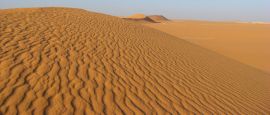Algeria Weather, climate and geography
Weather & climate
Summer temperatures are high throughout the country, particularly in the south where it is both very dry and very hot. During this time, road travel is difficult and air travel prone to delay because of sandstorms. Northern cities have high humidity, while those along the coast are cooled by sea breezes. In the winter, the oases of the far south are pleasant and attract many visitors. The desert temperature drops dramatically at night. North of the Sahara, temperatures are very mild from September to May and vary little between day and night. South of the Sahara, temperatures are pleasant from October to April, but there are great variations between day and night. Coastal towns are prone to storms from the sea. Rainfall is relatively low throughout the country and in the far south it is virtually unknown.
Cotton and linen lightweights are best for winter months and for evenings in desert areas. Woollens and light rainwear are advised for the winter along the coast and the Hauts Plateaux. Remember that desert temperatures can drop very low during the night, so don’t get caught out with only flimsy layers. South of the Sahara, from mid-December to mid-January, temperatures drop and warm clothes are necessary both in the morning and the evening. A mountain sleeping bag is also required when camping.
Geography
Algeria is situated along the North African coast, bordered to the east by Tunisia and Libya, to the southeast by Niger, to the southwest by Mali, and to the west by Mauritania and Morocco. It is Africa's second-largest country with 1,200km (750 miles) of coastline. Along the coastal strip are the main towns, fertile land, beach resorts and 90% of the population. Further south lies the area of the Hauts Plateaux mountains of up to 2,000m (6,600ft) covered in cedar, pine and cypress forests with broad arable plains dividing the plateaux. The remaining 85% of the country is the Sahara Desert in its various forms, sustaining only 500,000 people, many of whom are nomadic tribes with goat and camel herds. The Sahara region contains two mountain ranges: the dramatic Hoggar massif, rising to almost 3,000m (9,800ft) and the Tassili N’Ajjer. Both are scenically stunning and offer some of the best desert landscapes in the world.
Do you have any Feedback about this page?
© 2026 Columbus Travel Media Ltd. All rights reserved. No part of this site may be reproduced without our written permission, click here for information on Columbus Content Solutions.




 You know where
You know where